STE Highlights, November 2019
Awards and Recognition
Accelerator Operations and Technology
LANSCE operations streamlined by new adaptive feedback algorithm
Earth and Environmental Sciences
Improving nuclear detonation detection with transoceanic sensor systems
Materials Physics and Applications
New, most precise experimental limit on exotic electron–nucleon coupling
X-Theoretical Design
From simulation to sight: The telescope that will spot a direct-collapse black hole
Awards and Recognition
LANL staff receive Secretary of Energy Honor Awards
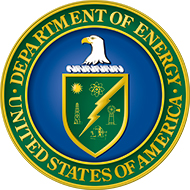
Numerous LANL staff received Secretary of Energy Honor Awards in November. The Honor Awards are the Department of Energy’s highest form of internal employee recognition, bestowed upon a group or team of DOE employees and/or contractors who together accomplished significant achievements on behalf of the Department. These groups demonstrate cooperation and teamwork in attaining their goals
Secretary of Energy Rick Perry presented the Honor Awards at a ceremony at DOE Headquarters on Nov. 19. The three teams receiving the awards are the Democratic People’s Republic of Korea Denuclearization Team, and the Warhead Measurement Campaign team, the Molybdenum-99 (Mo-99) Team, and the Pit Production Analysis Team.
See more information below on each award. For a full listing of LANL recipients of the awards, read the DOE news release on the awards here.
Democratic People's Republic of Korea (DPRK) Denuclearization Team
The Doe Secretary of Energy bestowed an Honor Award to LANL members of the DPRK Denuclearization Team. The award recognized the outstanding contributions of this multi-Laboratory team for having planned for the final, fully verified denuclearization of the Korean peninsula.
The team’s efforts played a major role in preparing for the historic U.S. DPRK Summit in Singapore, as well as the follow-on Summit in Hanoi, Vietnam. Furthermore, the team’s tremendous cooperation, ability to quickly adapt to changing circumstances and requirements, and dedication to the mission at hand, have ensured that the United States is expertly prepared to undertake a major effort to directly improve the security of the United States and the entire international community.
LANL recipients of this team award include Emily Schultz-Fellenz (EES Division); Sarah Hoover, Rick Mooday, and Dominic Purpura (GS-NCCP); Cory Johnson (A Division); Danielle Hauck (GS-NNS), and Don Dry (C Division).
Warhead Measurement Campaign Team
LANL staff received the Secretary of Energy’s Honor Award for their contributions to the Warhead Measurement Campaign (WMC) Team. The Warhead Measurement Campaign was a collaborative effort involving staff from Global Security and Weapons organizations at several national labs and a National Nuclear Security Administration (NNSA) production facility
The objective was to obtain a standardized set of radiation signature data from U.S. stockpile weapons to support treaty verification and emergency response studies, as well as other nuclear nonproliferation and defense program needs. The project also included a modeling effort to evaluate the current capability for predicting radiation signatures.
There were many challenging aspects to this project beyond the measurements and modeling, including the authorization process and "need-to-know" based security plans for protecting classified information. Over the course of the WMC, measurements were taken of many weapons and weapons components with a wide range of radiation detection techniques.
Comparisons between simulated and measured data were also performed. These activities resulted in a well-documented, consistent set of data that can be used to perform warhead verification studies, improve analysis techniques, and validate modeling tools, which can then be used to optimize detector design for future applications. This dataset is currently being sought out to support efforts in ways that were not necessarily anticipated in the original conception. This would not have been possible without the initiative, dedication, and extraordinary caliber of the multi-institution team.
Kate Frame (XTD Primary Physics, XTD-PRI) and Krista Meierbachtol (Advanced Nuclear Technology, NEN-2) each led the multi-Lab WMC team at various times throughout the life of this project.
Molybdenum-99 (Mo-99) Team
LANL staff received the Secretary of Energy's Honor Award for their contributions to the Molybdenum-99 Team and in recognition of the team’s outstanding achievement of bringing the first domestically produced Molybdenum 99 (Mo-99) to market in 30 years.
Mo-99 is a crucial medical radioisotope, used in over 40,000 medical diagnostic procedures in the United States every day. The Office of Material Management and Minimization Mo-99 Team dedicated countless hours over the past eight years to assist U.S. industry in resolving technical hurdles and maneuvering through a first-of-a-kind regulatory approval process.
In addition, the team supported the conversion of several global Mo-99 producers from the use of highly enriched uranium (HEU) targets to low enriched uranium targets. The Mo-99 Team's effort supports the DOE’s goal of minimizing the use of HEU in civilian applications and ensures that Mo-99 is available when needed so that U.S. patients continue to receive quality health care.
This Mo-99 production milestone was accomplished through coordination with private industry, the healthcare community, the national laboratories, the Nuclear Regulatory Commission, and the Food and Drug Administration. It is a monumental achievement that sets the United States on a course as a global leader in producing medical isotopes without the use of HEU.
Joetta Goda (Advanced Nuclear Technology, NEN-2) and Greg Dale (Accelerators and Electrodynamic, AOE-AE) were the two LANL staff on the Mo-99 team receiving the award.
Pit Production Analysis Team
The Pit Production Analysis Team provided outstanding effort in support of re-establishing the nation’s Plutonium Pit Production. On May 10, 2018, the NNSA Administrator provided a recommended alternative to revitalize the United States’ defense plutonium production capabilities and achieve the Department of Defense's requirement to produce no fewer than 80 pits per year by 2030.
The team’s work resulted in one of the most significant NNSA policy decisions in nearly a decades—identifying viable sites for the production of plutonium pits to ensure the future sustainment of the nuclear weapons stockpile. Their exceptional collaboration across the nuclear security enterprise in developing an analysis of alternatives, engineering assessment, and workforce analysis was an integral achievement and is the basis of this policy decision.
Brittany Atkinson (Pit and Production Program Office, CPO), Steven Mark Dinehart (Office of Nuclear & Military Affairs, NMA-PO), Drew Kornreich (Process Modeling and Analysis, E-2), Bob Putnam (Pit Technologies, PT-DO), and Brad Storey (CPO) were part of the Pit Production Analysis Team receiving this award.Los Alamos breaks record for R&D 100 Award wins
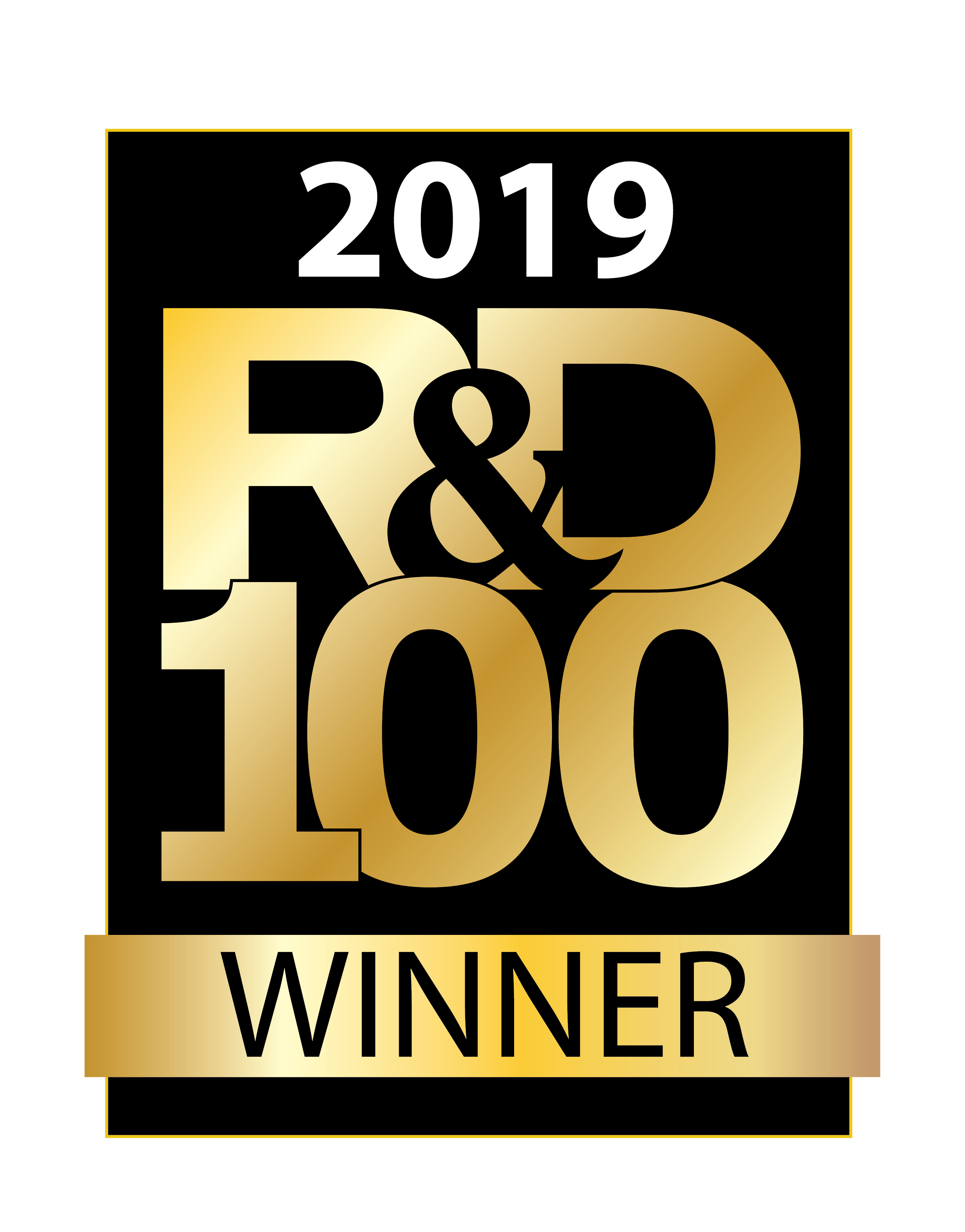
In 2019, Los Alamos set a new record for the number of R&D 100 Award wins in a given year. The Lab entered 11 submissions, all of which made it to finals and nine of which won. Additionally, three won special recognition awards, including a gold and silver award for corporate social responsibility, and a gold award for market disruptor products.
The prestigious “Oscars of Invention,” these awards honor the latest and best innovations and identify the top technology products of the past year. The R&D 100 Awards span industry, academia and government-sponsored research organizations.
The Lab’s finalists and winners were honored by Lab Director Thom Mason and Deputy Director for Science, Technology & Engineering John Sarrao at the Director’s Reception on Nov. 12, 2019. They will also be honored by R&D World magazine on Dec. 5, 2019, in San Franciscio, Calif.
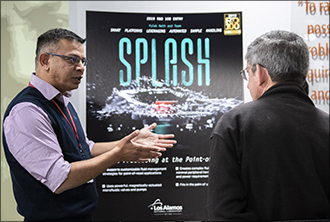
Pulak Nath, left, team lead of the R&D 100 Award winning entry SPLASH, talks to Lab Deputy Director for STE John Sarrao during the Lab's R&D 100 award ceremony.
The 11 submissions spanned the breadth of science and engineering, with the 2019 inventions including open-source software, sensors, coatings, explosives, and microfluidics.
The Los Alamos projects selected as R&D 100 Winners and Finalists are listed below. Click on the links to watch videos on the specific technologies.
ALFa LDS —The platform is an affordable, robust, autonomous system for the detection of natural gas leaks quickly and at low cost. Gas sensor data and atmospheric wind measurements from two compact instruments are fed into an artificial neural network that can detect, locate and quantify a leak. The lightweight instrument can be flown on a drone or attached to a vehicle to pinpoint, attribute, and distinguish natural gas leaks from biogenic methane sources.
Manvendra Dubey (Earth System Observations, EES-14) led the team of Bryan Travis, Keely Costigan, Jeremy Sauer, and collaborators from Aeris Technologies and Rice University.
Atomic Armor — The diamond-hard, flexible 2-D coating shields sensitive materials and devices from harsh environments while extending a device’s lifetime and maximizing its functionality. Atomic Armor can be coated on solid surfaces of any shape or material. The Materials by Design approach for the one-atom-thick tunable coating enables it to be customized for many applications, including selective permeability.
Nathan Moody (Accelerators and Electrodynamics, AOT-AE) and Hisato Yamaguchi (Finishing Manufacturing Science, SIGMA-2) led the team of Fangze Liu, Enrique Batista, Gaoxue Wang, Ping Yang, Vitaly Pavlenko, Philip Fernandes and Jeffrey DeFazio (Photonis Scientific, Inc).
In addition to the R&D 100 Award, Atomic Armor won a Gold Medal in the Market Disruptor-Products Special Recognition Category. This award is designed to highlight any product that has changed the game in any industry.
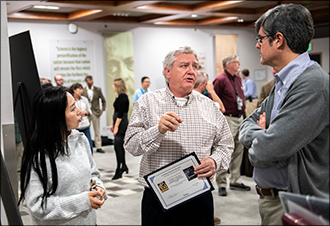
JiaJia Waters, left, and David Carrington, center, led the R&D 100 Award winners entry, FEARCE. Here they talk about their software system technology to Lab Director Thom Mason during the Lab's R&D 100 award ceremony.
BOM — The energetic material bis(1,2,4-oxadiazole)bis(methylene) dinitrate, or BOM, is the next generation of high-performance explosives. BOM is a higher-performing, safer explosive designed to replace toxic TNT in civilian and military applications. Unlike TNT, BOM is a standalone explosive that does not require the addition of an enhancer.
Los Alamos submitted the joint entry with the U.S. Army Research Laboratory. David E. Chavez (HE Science and Technology, M-7) directed the team of collaborators from the U.S. Army Research Laboratory.
DeltaFS — The DeltaFS open-source distributed file system for massively parallel applications creates, updates, and manages extreme numbers of files, alleviating the metadata bottleneck and accelerating highly selective queries. DeltaFS creates billions of files per second and does not require any additional compute resources or post-processing to create its data index. The performance and scalability capabilities that DeltaFS introduces are critical for storing and accessing data in the era of exascale computing.
Los Alamos led the joint entry with Carnegie Mellon University. Bradley Settlemyer (HPC Design, HPC-DES) directed the team of Gary Grider and collaborators from Carnegie Mellon University.
FEARCE — The software models engine motion, the motion of parts and their influence on the gases, multiphase injection of sprays and fuel droplets, the turbulent mixing of fuel and air, and subsequent chemical reactions in combustion engines. This modeling helps enable the design of engines for higher fuel efficiency and lower harmful emission. FEARCE models an engine’s operating properties and ranges that can’t be addressed readily with experiments. The software also enables designers to develop and optimize engines to run on alternative fuels, such as biofuels, which may require different operating conditions than those required for conventional fuels.
David Carrington (Fluid Dynamics and Solid Mechanics, T-3) leads the team with Jiajia Waters.
MC-15 Portable Neutron Multiplicity Detector — The MC-15 instrument is the smallest, lightest, and fastest portable neutron multiplicity detector, recording neutrons with 100-nanosecond time resolution. The MC-15 requires little training to operate, provides onboard or remote operation, and processes data in real time. Two units can be used in tandem to double the detection efficiency. The invention enables nuclear emergency response teams to quickly identify and assess nuclear-based threats, and it has applications for research in nuclear data and radiation transport validation.
Los Alamos led the joint entry with Lawrence Livermore National Laboratory and Sandia National Laboratories. The Los Alamos team consisted of Mark Nelson, Eric Sorensen, Brian Rooney, Richard Rothrock, Kiril Ianakiev, Metodi Iliev, Samual Salazar, Christopher Romero, David Jones, Jesson Hutchinson, and Matthew Newell plus collaborators from Lawrence Livermore National Laboratory and Sandia National Laboratories.
Severe Contingency Solver for Electric Power Transmission Analysis — Electric power transmission networks are critical for modern societies, but these networks are vulnerable to threats from extreme events. The Severe Contingency Solver open-source software analyzes severely damaged electric power networks that have hundreds to thousands of damaged components. The software removes the need for human intervention when assessing how damage from extreme events will restrict power delivery from utility grids.
Carleton Coffrin (Information Systems and Modeling, A-1) led the team of James Arnold, Scott Backhaus, Russell Bent, David Fobes, Kaarthik Sundar, and Byron Tasseff.
SimCCS2.0 — The open-sources software optimizes the design of carbon dioxide (CO2) capture, transport, and storage infrastructure while reducing industry’s carbon footprint and enhancing carbon tax credits and oil production. The fully integrated, end-to-end software package accounts for geographic and social constraints to geolocate pipelines in the real world. Industry, government, and stakeholders could use the software to design cost-effective pipeline networks linking CO2 sources (such as power plants) with sites where CO2 can be stored in deep saline aquifers or reused to increase oil and gas production.
Los Alamos led the joint entry with Indiana University and Montana State University. Richard Middleton (Computational Earth Science, EES-16) directed the team of Bailian Chen, Dylan Harp, Brendan Hoover, Rajesh Pawar, Philip Stauffer, and Hari Viswanathan plus collaborators from Indiana University and Montana State University.
In addition to the R&D 100 Award, SimCCS2.0 won a Silver Medal in the Corporate Social Responsibility Special Recognition Category. This award honors organizational efforts to be a greater corporate member of society, from a local to global level.
SPLASH — The miniature platform technology performs sequential operations involved in complex laboratory processes. SPLASH uses novel and powerful magnetically-actuated valves and pumps to create complex microfluidic circuits with minimal peripheral hardware, tubing, and power requirements. The small size and simplicity of operation enable automated sample preparation and processing for point-of-need applications.
Pulak Nath (MPA-Quantum, MPA-Q) led the team of Dylan Purcell, Jackson McFall, Aneesh Pawar, Tony Huang, Kiersten Haffey, and Hasibul Islam.
Unified Communications X (UCX) — As supercomputers move towards exascale—a quintillion calculations per second—they incorporate a variety of hardware and processing systems. All of the elements in these systems must communicate harmoniously to operate efficiently. UCX is an open-source software for high performance computers that allows diverse hardware systems and architectures to communicate by creating common interface definitions.
Los Alamos led the joint entry with Advanced Micro Devices, Argonne National Laboratory, Arm Ltd, Mellanox Technologies, NVIDIA, Stony Brook University, Oak Ridge National Laboratory, and Rice University. Stephen Poole (Associate Laboratory Directorate for Simulation and Computation, ALDSC) directed the team of Jeffery Kuehn and Howard Pritchard and collaborators from Advanced Micro Devices, ANL, Arm Ltd, Mellanox Technologies, NVIDIA, Stony Brook University, ORNL, and Rice University.
FINALISTS
RETRO Rx — Rapid, easy tools for responding to outbreaks and re-emergence events uses web-based information to assess infectious disease outbreaks and then provides visual analytics and actionable information to mitigate them and protect the population. The analytic tools require minimal effort and expertise and can be used for research, decision-making, analysis, forecasting, and training and education.
Alina Deshpande (Biosecurity and Public Health, B-10) led the team of Geoffrey Fairchild, Derek Aberle, William Rosenberger, Ashlynn Daughton, Nidhi Parikh, Antonietta Lillo, Nileena Velappan, Attelia Hollander, Emily Alipio Lyon, Forrest Altherr, Maneesha Chitanvis, Lauren Castro, Reid Priedhorsky, Grace Vuyisich, Eric Generous, Kristen Margevicius, Kirsten McCabe, and collaborators from University of New Mexico, University of Virginia, University of California – Santa Barbara, and Specifica Inc.
In addition to being an award finalist, RetroRx won the Gold Medal in the Corporate Social Responsibility Special Recognition Category. This award honors organizational efforts to be a greater corporate member of society, from a local to global level.
Falcon Plasma Focus — The device is a portable, compact neutron generator utilizing puled power technology. The technology produces short, high-output neutron pulses that can be applied to a variety of uses including nuclear material detection, explosives detection, materials research, and other industrial applications.
Nevada National Security Site Mission Support and Test Services LLC submitted the joint entry with Los Alamos National Laboratory, Sandia National Laboratories, Lawrence Livermore National Laboratory, University of Nevada, Las Vegas; Powder River Geophysical; Alameda Applied Sciences; Sigma Science/Keystone Global Engineering and Technology, Inc. Jessie Walker (Advanced Nuclear Technology, NEN-2) was the Los Alamos team member.
Technical contact: Jan Mercer-Smith
Marr-Lyon and team honored for counterterrorism and counterproliferation by NNSA
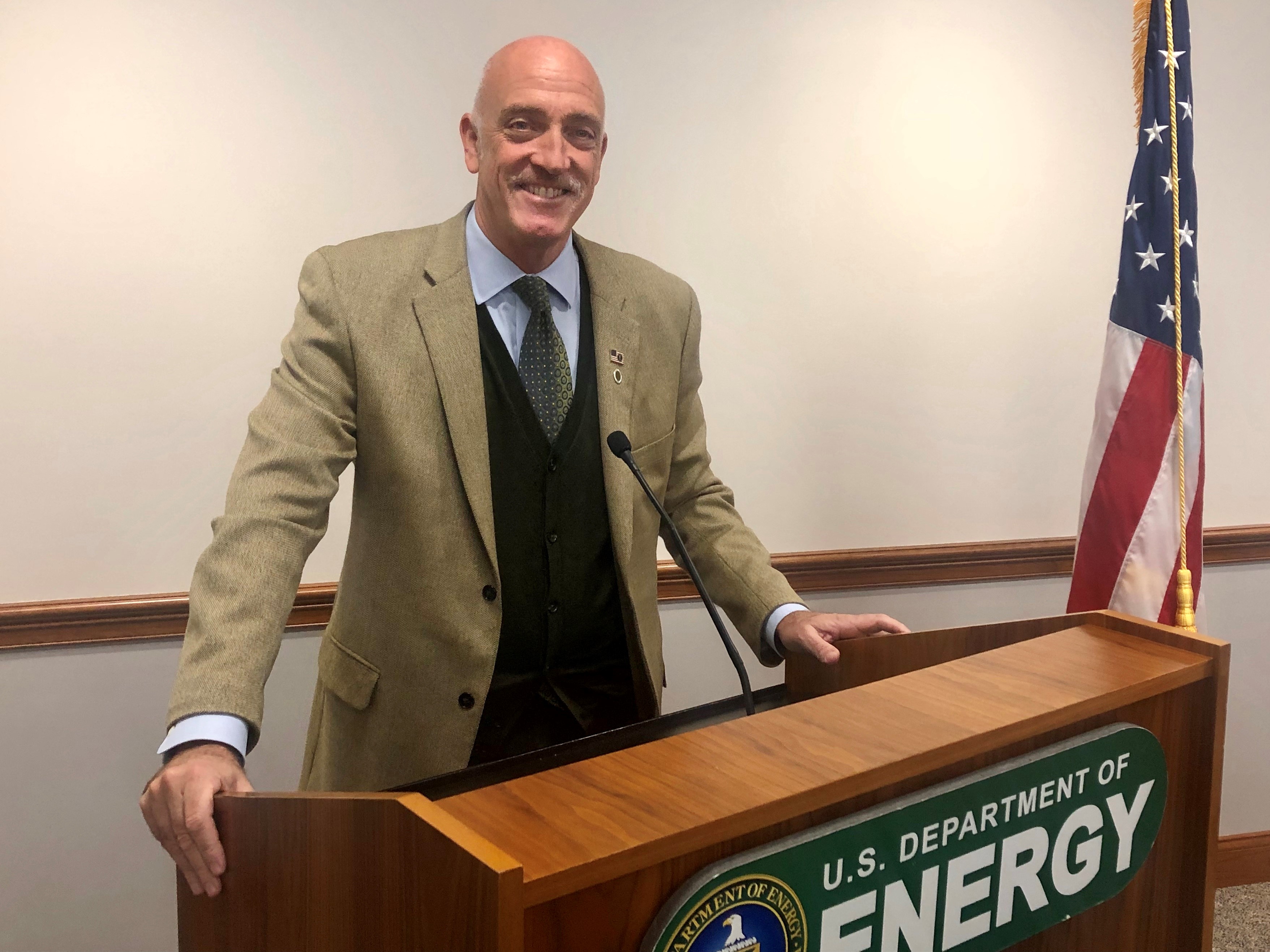
Jay Tilden, NNSA's Associate Administrator for Counterterrorism and Counterproliferation, recognized a LANL team for their work on the Standoff Disablement Program.
Mark Marr-Lyon (J-3), Daniel Garcia (XTD-NTA), Brian Key (NEN-5), Ian Fleming (XTD-SS), Trevor Wilcox (XTD-SS), and Beverly Duran-Cash (GS-NCCP) were honored for their work on the Standoff Disablement Program. The team received a recognition award from Jay Tilden, NA-80 of the National Nuclear Security Administration (NNSA).
Jay Tilden is the NNSA’s Associate Administrator and Deputy Under Secretary for Counterterrorism and Counterproliferation. Tilden guides the United States in preparing for, responding to, and successfully resolving nuclear and radiological accidents and incidents worldwide.
The Standoff Disablement Program is a joint NNSA/Department of Energy and Department of Defense program for counterterrorism and counterproliferation.
“This program demonstrates the value of a robust partnership between science and national security,” Marr-Lyon said. Technical contact: Mark Marr-Lyon
LANSCE awarded DOE funding for dark matter search
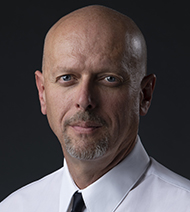
Richard Van de Water
On Oct. 1, 2019, the U.S. Department of Energy Office of High Energy Physics awarded $6.6M across four promising experiments toward the search for dark matter. The funding will be received over a four-year period. Richard Van de Water (Subatomic Physics, P-25) is leading the Los Alamos experiment: LANSCE Intense Proton Source Search for Sub-GeV Dark Matter.
“This opportunity represents a recent convergence of new models predicting low-mass dark matter and high-intensity particle accelerators such as LANSCE that can produce this type of elusive dark matter,” Van de Water said.
Van de Water, who was recently elected an American Physical Society Fellow, believes the discovery of dark matter will have a profound impact on our understanding of the Standard Model of Particle Physics and the origin and evolution of the universe.
The other three experiments funded include two from Fermilab in Batavia, Illinois, and one from SLAC in Menlo Park, California.Technical contact: Richard Van de Water
Accelerator Operations and Technology
LANSCE operations streamlined by new adaptive feedback algorithm
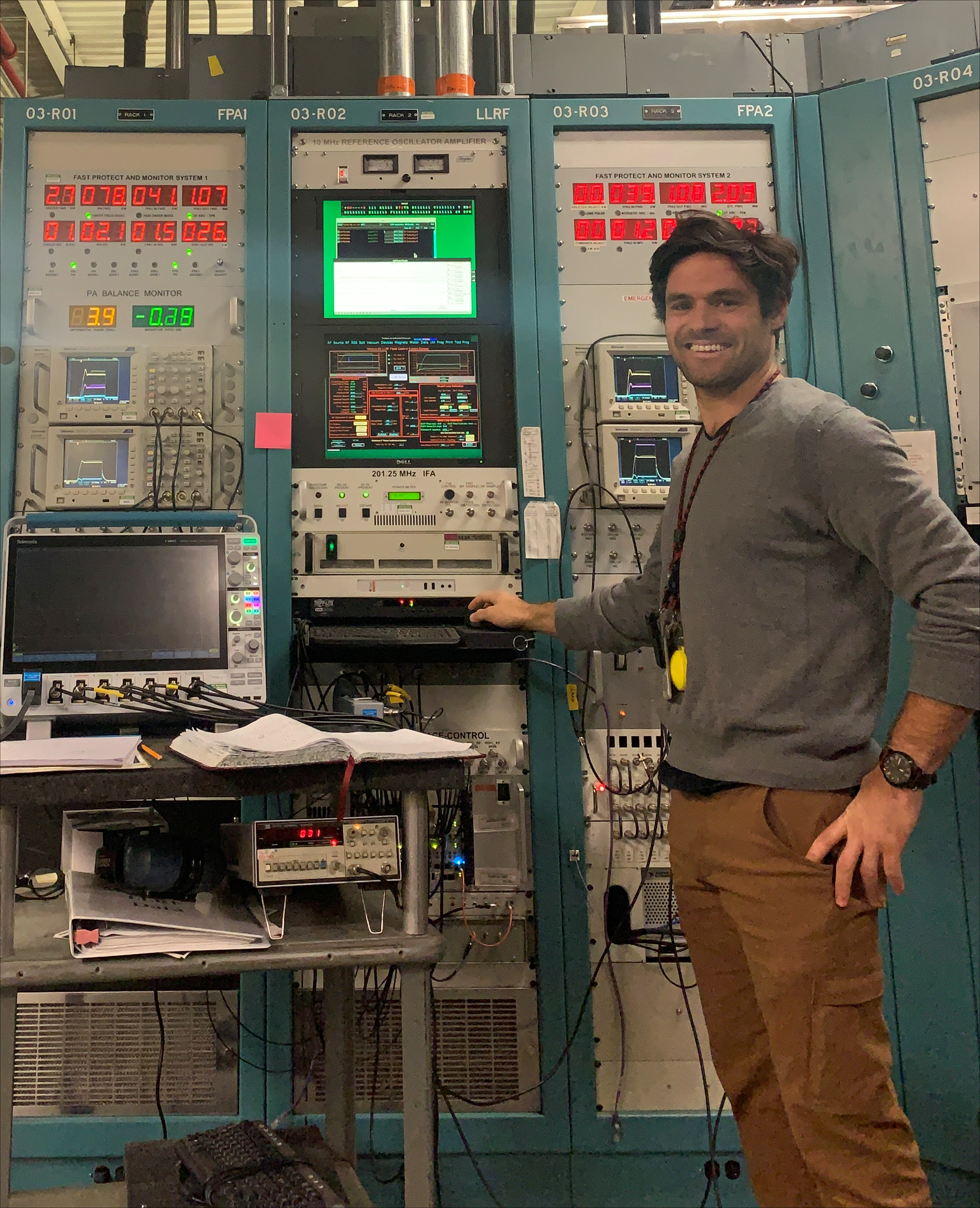
Alexander Scheinker at LANSCE. LANSCE is a one-mile linear accelerator that simultaneously supports five state-of-the-art scientific centers, including pRad and the Lujan Center.
The Los Alamos Neutron Science Center (LANSCE) is like a living creature—constantly moving and changing. The initial shape of the particle beam, the electric fields in the accelerating cavities, and the magnetic fields that force charged particles to flow in a straight line are constantly drifting on their own (growing and shrinking) even when nobody touches the machine, and experience large changes when experimental tweaks are made, such as adjusting the energy or reorganizing into different alignments.
Mitigating the resulting side effects of those drifts and tweaks is a challenge, but is required to provide high-quality beam to the more than 600 scientists who use LANSCE each year. A new adaptive algorithm developed by Alexander Scheinker (Accelerator Operations and Technology, AOT) may be the answer.
Human operators control the LANSCE beam
Operators must manually tune the machine before each use and while the machine is running. They keep the beam from getting too far out of whack, preventing beam loss and maintaining experiment quality.
“The beam and accelerator components can all change, even if no one touches the accelerator,” Scheinker said. “One time, we tuned everything and then had a power surge. No one moved the settings, but after it came online again the beam losses were way higher.”
A particular risk of an untuned beam is particles burning a hole in the copper sidewall. This is a difficult problem to fix, and one that Jason Burkhart (AOT certified copper welder) recently dealt with.
Manually tuning, albeit important, takes time. There are more than 300 variables (250 adjustable magnets and 50 accelerating cavities) that control the beam’s scatter and trajectory. The time it takes to tune is subtracted from a researcher’s allotted time slot.
Adaptive feedback algorithm saves valuable research time
Scheinker developed an adaptive algorithm, a type of machine learning, to quickly tune the LANSCE beam. This algorithm significantly cuts tuning time, allowing more time for actual research.
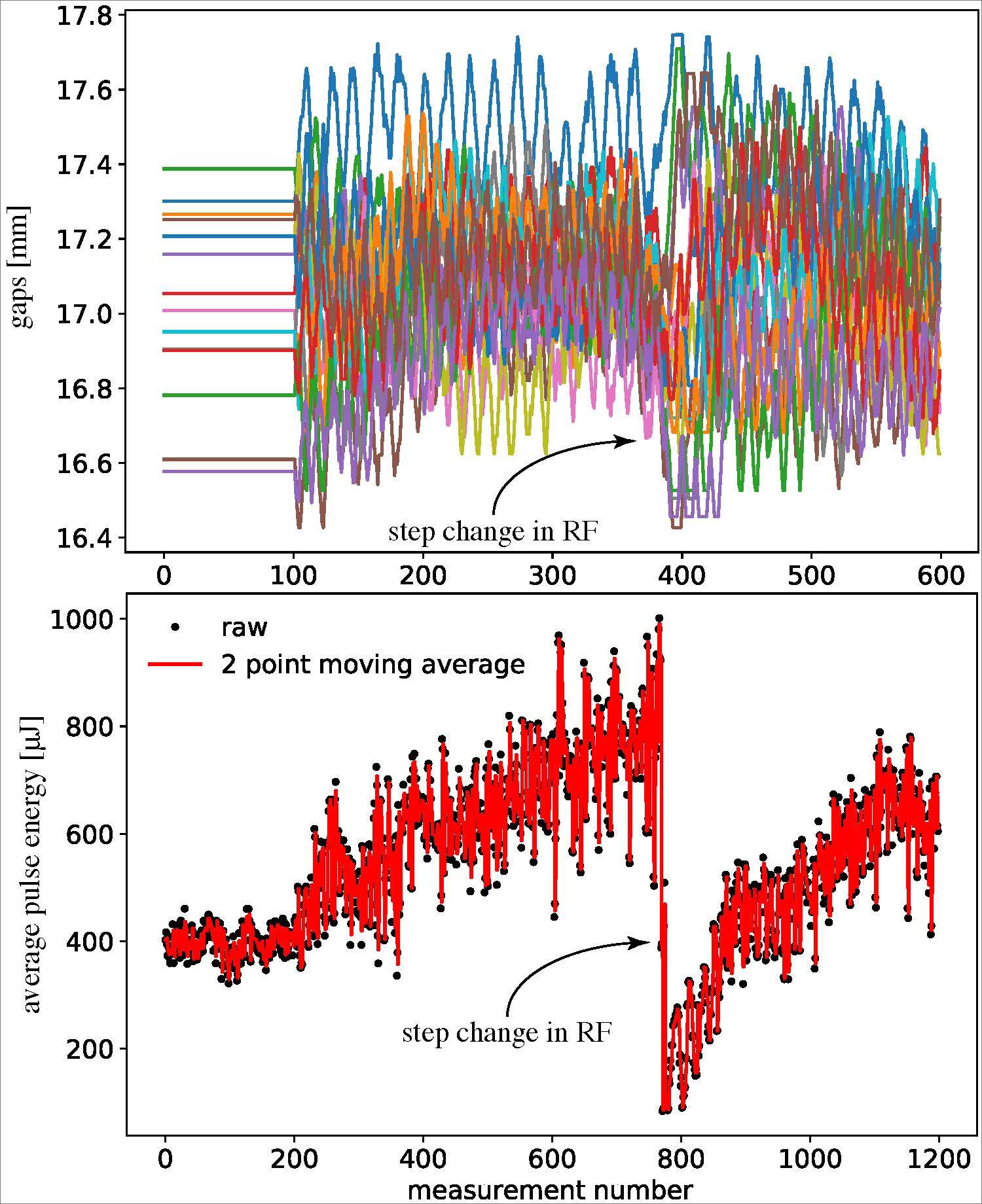
During tuning at the European X-ray FEL, a large step change in the rf system causes a sudden drop in the average bunch energy. The adaptive algorithm is seen to automatically begin readjusting 15 undulator phase-shifter magnet gaps to compensate for this.
Typical machine learning works by studying an environment, analyzing feedback, and then applying a set of rules to produce an intended result. However, this becomes much more complicated in an accelerator, where the environment is constantly changing. Scheinker’s algorithm reacts to this change—it is adaptive.
Scheinker and collaborators from two other accelerators, the Linac Coherent Light Source at SLAC and the European x-ray free electron laser at DESY, tested this algorithm. They demonstrated it is a robust, model-independent method for tuning coupled particle accelerator components, and they can tune up to 105 parameters simultaneously—a major strength.
Their research demonstrated the success of this algorithm for tuning initial SASE by adjusting various components, the longitudinal phase space, phase shifter gaps, and aircoils.
At LANSCE, Scheinker recently tested his adaptive algorithm when the power surge occurred. “We had the accelerator back to normal in about five minutes,” Scheinker said.
Worldwide impact of this algorithm
There are more than 30,000 particle accelerators around the world that could benefit from this algorithm, but Scheinker also said it could be used in any situation with an environment in constant flux—noise-canceling headphones, airplanes, or in military situations in which the United States needs to destroy an incoming missile.
“Really,” Scheinker said, “it can be used for anything in which we need to account for constant change.”
Mission
This research supports the Laboratory’s Nuclear Deterrence and Global Security mission areas. It also supports the Information, Science & Technology science pillar.
References:
Alexander Scheinker (AOT), Dorian Bohler (SLAC National Accelerator), Sergey Tomin (European XFEL), Raimund Kammering (Deutsches Elektronen-Synchrotron DESY), Igor Zagorodnov (DESY), Holger Schlarb (DESY), Matthias Scholz (DESY), Bolko Beutner (DESY), and Winfried Decking (DESY). “Model-independent tuning for maximizing free electron laser pulse energy.” Phys. Rev. Accel. Beams. 22, 082802 (2019). DOI: https://doi.org/10.1103/PhysRevAccelBeams.22.082802
Alexander Scheinker (AOT), Auralee Edelen (SLAC Natnl Accelerator), Dorain Bohler (SLAC), Claudio Emma (SLAC), and Alberto Lutman (SLAC). “Demonstration of model-independent control of the longitudinal phase space of electron beams in the Linac-coherent light source with Femtosecond resolution.” Physical review letters, 121(4), 044801 (2018). DOI: https://journals.aps.org/prl/pdf/10.1103/PhysRevLett.121.044801
Technical contact: Alexander Scheinker
Bioscience
Genomics and disease: Unraveling the ties
Genomics is an ever-burgeoning field of learning the who, what, where, when, and why of genes and their resulting products. As the human race learns to deal with larger and larger datasets, we glean more about our vast sequence of genes and what role those genes play in disease.
Researchers in Los Alamos’ Bioscience (B) Division are using their expertise in genomics to further understanding of diseases like Crohn’s, pancreatic cancer, and heart disease. They are finding ties between sequenced bacteria that exist in the human gut as well as biomarkers (e.g., microRNAs) to these specific diseases.
The gut microbiome is tied to disease
The human gut is populated by various bacterial strains. This environment is different from person to person, but it plays a role in metabolism, immune homeostasis, and disease. Gut “dysbiosis,” or having an imbalanced microbiome, is implicated in cardiovascular complications.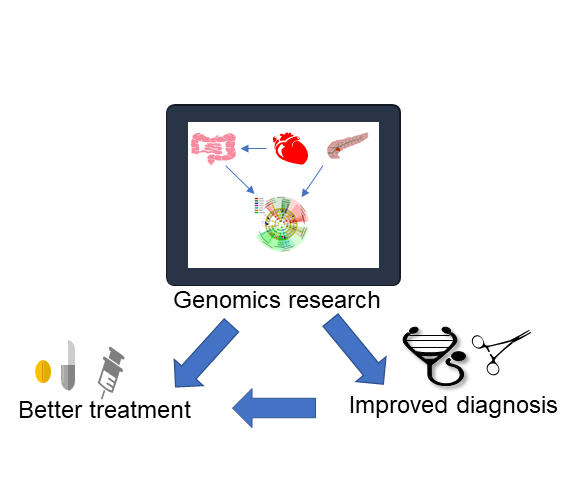
The Los Alamos researchers, along with collaborators, hypothesized a link between dysbiosis and heart issues, specifically acute coronary syndrome (ACS). The researchers used next-generation sequencing techniques in their study to determine patients’ microbiomes. Their conclusions point to a feedback loop of dysbiosis causing gut permeability, which leads to further dysbiosis. However, it is unclear whether dysbiosis and leaky gut are mere associations or key contributing factors in acute cardiac events; therefore, large-scale exploratory studies are required to determine the exact role of dysbiosis in ACS patients.
Crohn’s disease is another ailment linked to the microbiome. So the researchers isolated and sequenced a specific bacterium, Parabacteroides distasonis, which is thought to worsen gut permeability and is tied to Crohn’s disease. Their data will help future Crohn’s studies.
Detect microRNA, detect pancreatic cancer
The pancreas is part of the digestive system as well. Pancreatic cancer is one of the most aggressive and fatal forms of cancer, in part because it is challenging to detect early on. The Los Alamos researchers linked pancreatic cancer to microRNA, which can be sequenced and lead to earlier detection of pancreatic cancer.
Beyond that, these microRNA can be used as therapeutic targets. Turning on or turning off these bits of RNA could be a novel form of anticancer therapy.
Funding and mission
This work was funded by a Laboratory Directed Research and Development award, a National Institutes of Health (NIH) grant, and a LANL Director’s Postdoctoral Fellowship grant. This research supports the Laboratory’s Global Security mission area and the Science of Signatures and Information, Science & Technology science pillars.
References:
Tarik Alhmoud (University of New Mexico [UNM]), Anand Kumar, Chien-Chi Lo, Rana Al-Sadi (UNM), Stacey Clegg (UNM), Iha Alomari (University of California Irvine), Tarek Zmeili (UNM), Cheryl Diane Gleasner (B-10), Kim Mcmurry (B-10), Armand Earl Ko Dichosa (B-10), Momchilo Vuyisich (Viome), Patrick Sam Guy Chain (B-10), Shiraz Mishra (UNM), Thomas Ma (UNM). “Investigating intestinal permeability and gut microbiota roles in acute coronary syndrome patients.” Human Microbiome Journal. 2019. DOI: https://doi.org/10.1016/j.humic.2019.100059
Falong Yang (Case Western), Anand Kumar (B-10), Karen Walston Davenport (B-10), Julia Mae Kelliher (B-10), Jessica C. Ezeji (Case Western), Caryn E. Good (Cleveland Medical Center), Michael R. Jacobs (Cleveland Medical Center), Mathew Conger (Case Western), Gail West (Lerner Research Institute), Claudio Fiocchi (Lerner Research Institute), Fabio Cominelli (Case Western), Armand Earl Ko Dichosa (B-10), Alexander Rodriguez-Palaciosa (Case Western). “Complete Genome Sequence of a Parabacteroides distasonis in patient with Crohn’s Disease.” Microbiology Resource Announcements, 8:36 (October 2019). DOI: 10.1128/MRA.00585-19
Manmeet Rawat (UNM), Kavita Kadian (Kumaun University, India), Yash Gupta (Loyola Univ. Med Center), Anand Kumar (B-10), Patrick S.G. Chain (B-10), Olga Kovbasnjuk (UNM), Suneel Kumar (Rutgers), and Gulshan Parasher (UNM). “MicroRNA in Pancreatic Cancer: From Biology to Therapeutic Potential.” Genes 2019, 10, 752; DOI: https://doi.org/10.3390/genes10100752
Technical contact: Anand KumarEarth and Environmental Sciences
Improving nuclear detonation detection with transoceanic sensor systems
Seismology is a critical piece of the multi-part approach to nuclear detonation detection worldwide, which is an important component of Los Alamos National Laboratory’s global security mission. Not only can seismology detect an explosion source and provide a location and origin time, but it can provide answers regarding magnitude and discriminate among source types.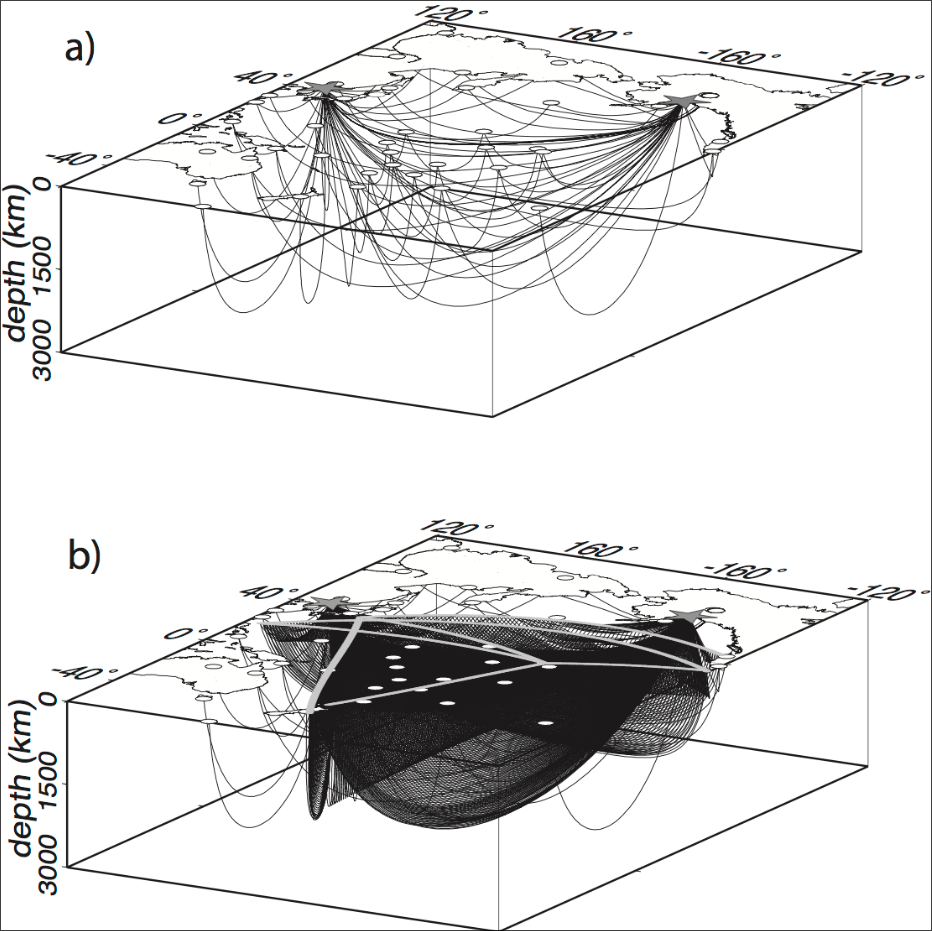
a) Seismic raypaths sampling the Earth for two earthquakes as observed at current Global Seismic Network (GSN) stations; one source is in Prince William Sound, Alaska, and the other is on the Korean Peninsula. Sources = gray stars; stations = gray circles. b) Seismic raypaths for the same two sources, as recorded by the GSN stations augmented by notional first-generation SMART cables, illustrating the seismic ray coverage improvement. Cable sensors are shown as gray circles distributed at 75-km intervals along the cables
To do this, seismologists must have a good understanding of Earth’s seismic characteristics and the ways they affect seismic wave propagation. Decades of seismic monitoring provide data recorded at sensors all around the globe; however, these sensors are largely restricted to land. Nearly three-quarters of the Earth's surface is covered with water. The heterogeneous distribution of seismic sensors and sources means our seismic sampling of the Earth is uneven at best. Ocean Bottom Seismometer (OBS) efforts have been expanding, but these studies are largely near-shore and generally do not provide real-time data.
Three United Nations’ agencies are sponsoring an international Joint Task Force to develop Science Monitoring And Reliable Telecommunications (SMART) cables. SMART cables will be an upgrade to the existing system of global transoceanic telecommunications cables, via the addition of geophysical sensors at regularly spaced signal repeaters along these cables. Although the effort is primarily aimed at collecting oceanographic data that will focus on sea-level rise, tsunami early warning, and climate change, the sensors will also include seismic accelerometers on the seabed, providing dense, real-time data covering vast regions never-before instrumented.
To address the anticipated improvement in global seismic sampling that will arise from SMART cables, researchers in LANL’s Earth and Environmental Sciences Division’s Geophysics Group (EES-17) performed forward 3D modeling of the Earth, comparing the seismic rays captured by existing sensors to the coverage afforded by the addition of notional first-generation SMART cables.
Their research concluded that in some parts of the Pacific, our sampling of the Earth would improve by a factor of more than 300%, providing not only enhanced ability to improve location estimates for earthquakes and explosions, but also (through real-time data) improving our detection capability for sources in regions previously difficult to observe. Success of the SMART cable initiative will greatly enhance our capabilities for nuclear explosion monitoring.
Funding and mission
This research was supported through a Pathfinder award from the LANL Associate Laboratory Director for Global Security, the Los Alamos Center for Space and Earth Science, and an internship from the New Mexico Consortium. This work also benefits from the Ground-Based Nuclear Detonation Detection program of the U.S. Department of Energy’s National Nuclear Security Administration. The work supports the Laboratory’s Global Security mission area and the Science of Signatures and the Information, Science & Technology capability pillars.
References:
Joint Task Force for SMART Cables. “SMART Cables for Observing the Global Ocean: Science and Implementation.” Front. Mar. Sci. 2019. https://doi.org/10.3389/fmars.2019.00424
Nishath Ranasinghe (New Mexico Consortium), Char Rowe (EES-17), Ellen Syracuse (EES-17), Carene Larmat (EES-17), and Mike Begnaud (EES-17). “Enhanced Global Seismic Resolution Using Transoceanic SMART Cables.” Seismological Res. Lett. (2017). doi: https://doi.org/10.1785/0220170068
Technical contact: Char RoweMaterials Physics and Applications
New, most precise experimental limit on exotic electron–nucleon coupling
Fermions are subatomic particles, such as electrons and nucleons, considered to be the building blocks of matter. Fermions interact with each other through fields, and bosons, such as photons and gluons, are the subatomic particles attributed with mediating those interactions.
In addition to four fundamental interactions—weak, strong, gravitational, and electromagnetic—there could exist another type of fundamental interaction mediated by an exchange of new fundamental bosons, which are far less understood. Such interactions are called “exotic” interactions, as they are present beyond the Standard Model of particle physics. The strength of exotic coupling between fermions should be determined by experiments; however, it is extremely weak and challenging to detect.
Until recently, experimental methods to study exotic interactions have been limited, and understanding how closely two fermions need to be in order to interact has not been clear. To answer this question, Los Alamos researchers developed a precise experimental approach to constrain an exotic electron–nucleon coupling.
Atomic magnetometer technique improves sensitivity
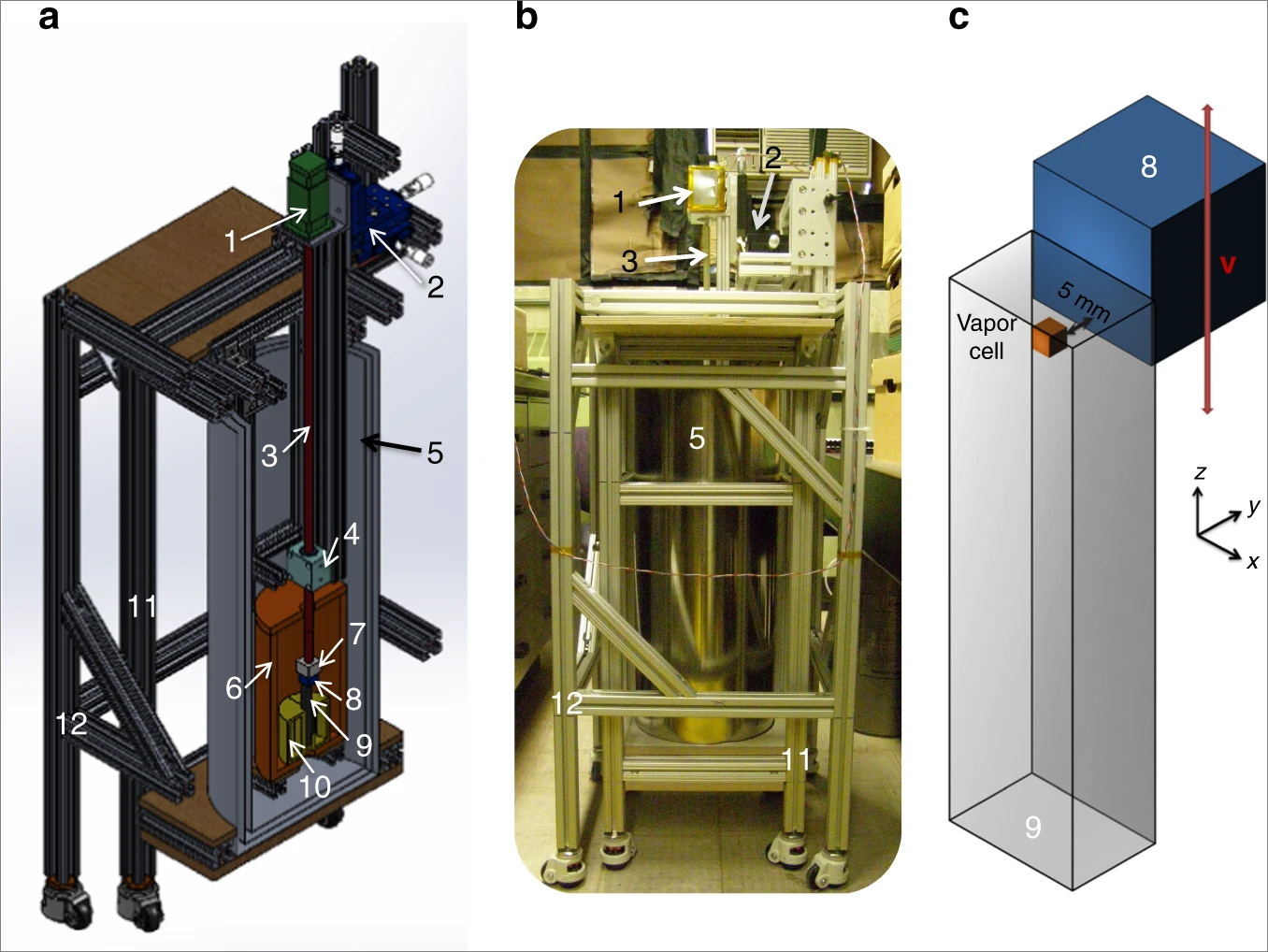
The experimental setup. (a) The setup to probe the exotic interaction. (b) A photo of the actual setup. (c) A schematic of the configuration of the atomic magnetometer and the solid-state mass.
Los Alamos researchers from Materials Physics and Applications (MPA-Q) used an atomic magnetometer, the most sensitive non-cryogenic magnetic-field sensor, to experimentally probe exotic electron–nucleon coupling. This setup offers sensitivity in the femtotesla range.
The experiment uses a rubidium atomic vapor of atomic magnetometer, which provides polarized electrons, and a solid-state mass containing unpolarized nucleons. The atomic magnetometer can precisely detect an effective magnetic field induced by the exotic electron–nucleon coupling. The effective magnetic field changes as a function of distance between the interacting electron and nucleon and their relative velocity.
Using a Monte Carlo integration, the exotic electron–nucleon coupling has been experimentally constrained to be geAgNV < 10−30 at the mediator boson mass less than 10−4 eV, equivalent to the interaction range larger than 10−3 m. This improves the current limit by up to 17 orders of magnitude.
Mystery particle mediates exotic interaction
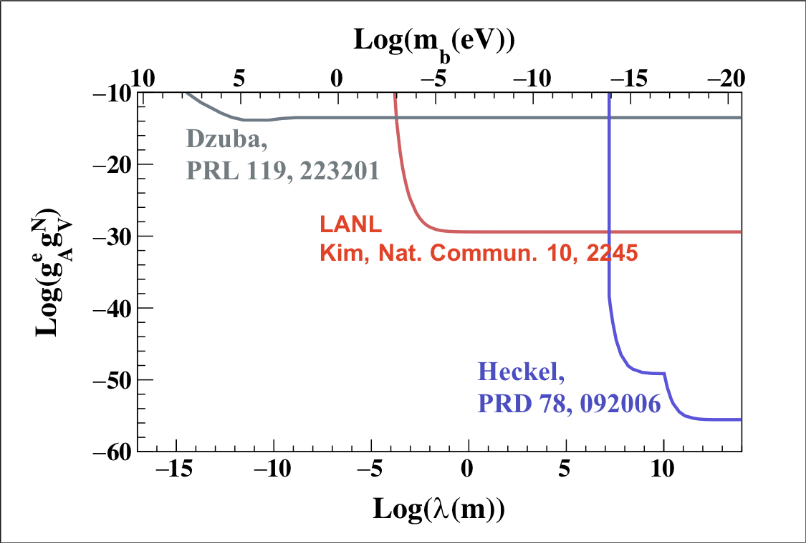
Experimental constraint of the LANL experiment on the exotic electron–nucleon coupling as a function of the interaction range in the bottom axis and the mediator boson mass in the top axis. The LANL experiment significantly enhances the current constraint by up to 17 orders of magnitude.
Scientists believe the exotic interaction is mediated by a yet-unseen particle, the most plausible candidates being two types of bosons: the axion and the hidden photon. The discovery of either boson could explain some of the enigmas in modern physics, including the nature of dark matter and dark energy, the strong charge-parity problem, and the matter–antimatter asymmetry of the Universe. This research will help develop directions for finding those answers.
The researchers also have ideas about how to improve sensitivity of their technique even further. The current work uses a single-beam configuration in the atomic magnetometer, but future work could employ an orthogonal-beam configuration. This is anticipated to reach a subfemtotesla sensitivity range.
Funding and missions
This work was funded by Los Alamos’s Laboratory Directed Research and Development Program (LDRD Exploratory Research grant). The work supports the Laboratory’s Global Security mission and Nuclear and Particle Futures capability pillar by contributing to the grand scientific challenge of discovering physics beyond the Standard Model.
Reference: Young Jin Kim, Ping-Han Chu, Igor Savukov, Shaun Newman (MPA-Q). “Experimental limit on an exotic parity-odd spin- and velocity-dependent interaction using an optically polarized vapor,” Nature Communications. 10, 2245 (2019). DOI: https://doi.org/10.1038/s41467-019-10169-1. Technical contact: Young Jin Kim
Materials Science and Technology
Nuclear fuel progress: New simulation capability for noncollinear magnetic configurations in uranium dioxide
Uranium dioxide is the primary nuclear fuel used in the current fleet of light-water reactors and continues to be developed for improved performance, economics, and accident tolerance. For example, by adding chromium in the form of Cr2O3 to fuel pellets, larger grains are formed compared to standard UO2 fuel, which may lead to increased fission gas retention, improved plasticity, and a softer pellet. These modifications are beneficial for fuel performance and could result in improved coping time in the case of an accident.
Despite the long history of UO2 nuclear fuel applications, there are still unanswered scientific questions, which limits our ability to model its properties from first principles. This is especially important for new fuels where experimental data and corresponding empirical models are rare. Many of these limitations originate from the behavior of the uranium f-electrons and the complex magnetic properties they give rise to.
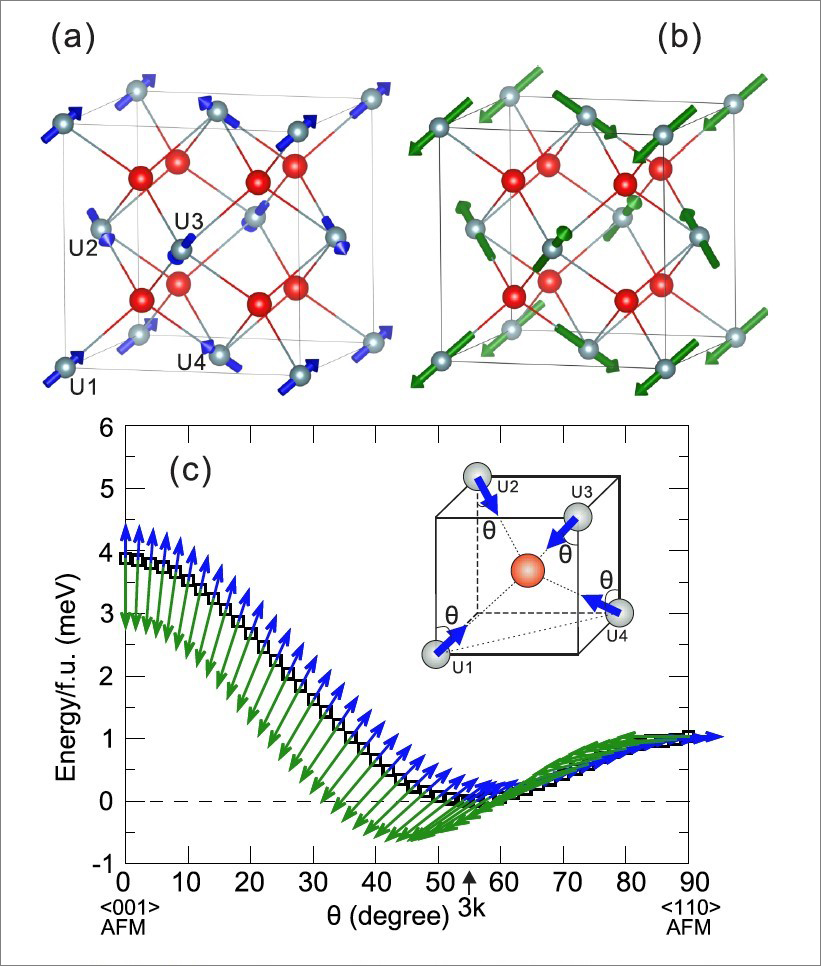
Schematic view of (a) spin and (b) orbital moments in a 3k (longitudinal) magnetic unit cell of UO2. (c) The total energy as a function of the canting angle theta. Blue and green arrows show the spin and orbital moments, respectively. Inset explains the definition of the spin canting angle theta.
To address this knowledge gap, a collaboration between scientists from Los Alamos National Laboratory, the United Kingdom, Austria, Japan, and Italy developed a new model for noncollinear magnetism in UO2 to study multipolar behavior.
The work was led by Sergei Dudarev at Culham Centre for Fusion Energy in the United Kingdom, and much of it was performed as part of a visit (funded by the Centre for Non-Linear Studies) to Los Alamos National Laboratory.
Importance of magnetic properties for nuclear fuel performance
The magnetism of UO2 is a fundamental property most clearly manifested at very low temperatures, but it also has implications for important properties at room temperature and above. For example, our previous studies have shown low thermal conductivity of UO2—which is one of the main drawbacks for fuel performance—is caused by phonons or lattice vibrations carrying heat interacting with electronic and spin degrees of freedom to scatter phonons, thus drastically reducing conductivity. This effect is not only observable for very low temperatures but it persists up to room temperature and potentially all the way up to temperatures of relevance to nuclear fuel applications.
The impact on thermal conductivity only occurs in the paramagnetic phase or equivalently for disordered magnetic moments, and the interaction is suppressed below the magnetic ordering (Néel) temperature around 30 K. Before addressing this interaction in the paramagnetic phase from first-principles, the coupling between the lattice and spin degrees of freedom must first be accurately modeled and characterized for the case of a static lattice at 0 K. Specifically, the spin and orbital contributions to the UO2 magnetic properties must be properly modeled and understood.
New Hubbard U model and multipolar order in UO2
In the present study, the so-called Hubbard U model often applied for studying UO2 is corrected to more accurately describe the noncollinear magnetic properties. The U parameter is shown to be the only free parameter in this model, unlike earlier formulations that also included the Stoner parameter J, and its value is calculated using the random phase approximation. The spin and orbital magnetic degrees of freedom are shown to be strongly coupled, making them virtually inseparable.
As expected, the researchers’ model predicts the experimentally observed 3k magnetic structure to be the most stable at 0 K. By using a multipolar pseudospin Hamiltonian, the researchers show how octupolar and dipole–dipole exchange coupling are responsible for establishing the 3k magnetic ground state. Somewhat surprising, the cooperative Jahn–Teller effect leading to distortions of the atoms from the ideal fluorite structure does not appear to play a significant role in stabilizing the noncollinear 3k state, which has the lowest energy, even in an undistorted lattice.
These results will enable improved first-principles models of the dissipative processes involved in reducing the phonon-mediated thermal transport, for example. The next step will be to use the new capability to parametrize a model for finite temperature coupled spin and molecular dynamics simulations, which are expected to answer important questions related to thermal transport for application in nuclear performance simulations.
Funding and mission
This study was enabled by a visit from Dr. Sergei Dudarev to Los Alamos National Laboratory funded by the LANL Center for Nonlinear Studies (CNLS). Work at Los Alamos National Laboratory was funded by the DOE Office of Nuclear Energy under the Nuclear Energy Advanced Modeling and Simulation (NEAMS) Program and the Nuclear Energy University Partnership. The work supports the Laboratory’s Energy Security mission area and the Nuclear and Particle Futures capability pillar.
Reference: S. L. Dudarev (UK Atomic Energy Authority and Imperial College London), P. Liu (University of Vienna), D. A. Andersson (Materials Science and Technology Division [MST] Division), C. R. Stanek (MST), T. Ozaki (University of Tokyo), and C. Franchini (University of Vienna and Universita di Bologna). “Parametrization of LSDA+U for noncollinear magnetic configurations: Multipolar magnetism in UO2.” Phys. Rev. Materials 3, 083802 (2019) DOI: https://doi.org/10.1103/PhysRevMaterials.3.083802. Technical contact: David Andersson and Chris Stanek
Next-gen LDRD: COMIC aligns high-risk research with mission needs
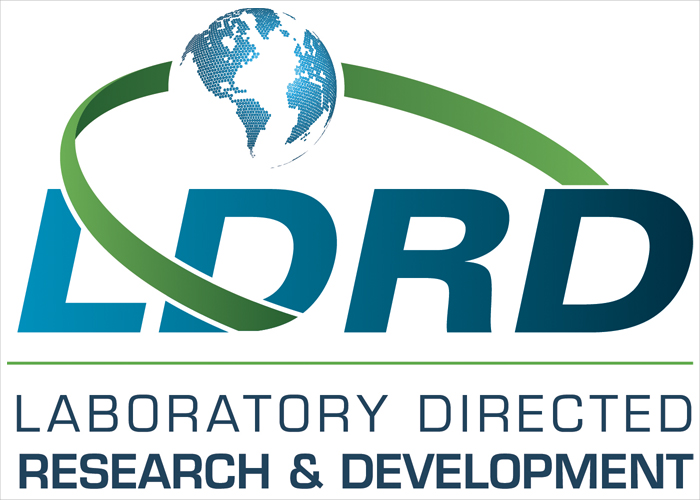
Each year the Laboratory Directed Research and Development (LDRD) program at Los Alamos selects high-risk, high-reward research to fund for a finite time. The Directed Research (DR) component is LDRD’s flagship investment, which explores mission solutions via multi-disciplinary teams. For fiscal year 2020, 14 DR proposals were funded at LANL. Among them is a particularly unique project led by Laurent Capolungo (Materials Science and Technology; MST-8) and John Carpenter (Sigma).
Cross-discipline, cross-generation
“Control of microstructural instability in composites, or COMIC, is so interdisciplinary it could only be accomplished at Los Alamos,” Capolungo said.
COMIC is a “Materials for the Future” project that aims to discover damage-resistant metals. That will require (1) making new materials, (2) characterizing those materials, and (3) predicting how those materials will fail. Capolungo and Carpenter are calling upon Los Alamos experts from Sigma, MST, X-Computational Physics, Materials Physics and Applications, and Theoretical to realize this vision.
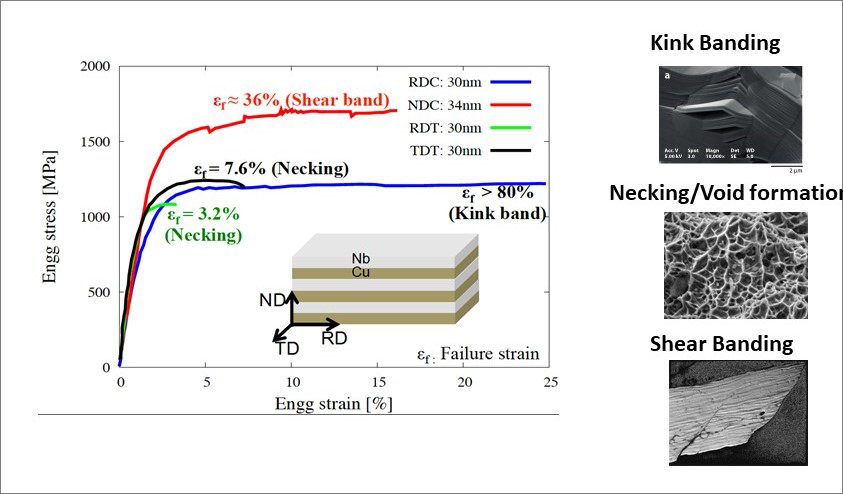
Mechanical response of Cu/Nb subjected to uniaxial tension (T) or compression (C) along the rolling (RD) normal (ND) or transverse directions (TD). As shown, three different failure modes can be triggered in the same material system.
Beyond field experts, the LDRD funding enables Capolungo to involve early career scientists as well. “It’s an opportunity to invest in the next generation,” Capolungo said, “and I’m excited to mentor them.”
It’s critical to design materials that will fail
The premise of COMIC is to design nano-metallic laminate composites that will fail in a predictable way. They want to be able to predict how, when, and why the material failed. Being able to model and predict a material’s behavior will close the loop on understanding the relationship between microstructure and performance.
The specific traits they are trying to tease apart are plastic anisotropy and material interfaces. These tend to be conflated factors. The new materials these researchers are making will offer complicated and different interfaces—diffuse with secondary phases. These go beyond the normal definition of a complicated interface, such as an immiscible semi-coherent interface.
“Previous LDRDs have shown that tailoring interfaces through process control can lead to combinations of highly desirable properties, such as thermal stability, high strength, and resistance to irradiation damage,” Carpenter said. “However, in this program, we are not as interested in improving material properties, rather we want to fundamentally understand and develop predictive models for why materials fail. This knowledge is what unlocks a paradigm shift in materials engineering where the ‘weak links’ that lead to failure in a given application can be understood and avoided during manufacturing.”
Right now, engineers build in “safety factors” to control for uncertainty in material lifetime, and this often leads to heavier-than-necessary components in energy applications, such as nuclear reactors and automobiles. Gaining a better understanding of the relationships between failure, loading conditions, and material microstructure will streamline engineering and material selection for national security and beyond. COMIC will pave the way toward modeling and designing more resilient metals processed through conventional or advanced manufacturing techniques and exposed to extreme environments.
Forethought on program transition ensures mission relevance
Capolungo and Carpenter are marking a number of milestones with COMIC, and ensuring mission relevance is one of them. Often, transitioning LDRD programs upon completion of their three-year funding is not guaranteed because the research at the completion of the funding period does not always continue to align well with mission needs. COMIC will be approached differently.
“We created a stakeholder advisory board,” Capolungo explained, “and we will touch base with them every six months or so to discuss aspects of the project that could be relevant to mission needs.” This advisory board’s feedback will help shape the LDRD research as it moves through its funding period, before transition. This method represents a new style of interaction that will promote tight coupling between scientific discovery and LANL missions, as they both evolve over the course of the funding period.
Funding and mission
COMIC is funded by a LANL LDRD directed research grant. It supports the Laboratory’s Global Security mission area and the Materials for the Future and Science of Signatures science pillars.
Researchers: Laurent Capolungo (principal investigator, Materials Science in Radiation and Dynamics Extremes, MST-8); John Carpenter (co-principal investigator, Finishing Manufacturing Science, Sigma-2); Ricardo Lebensohn, (Fluid Dynamics and Solid Mechanics, T-3); Saryu Fensin (MST-8); Nan Li (Center For Integrated Nanotechnologies, MPA-CINT); Rodney McCabe (MST-8); Xiang-Yang Liu (MST-8); Abigail Hunter (Materials and Physical Data, XCP-5); Arul Mariyappan (MST-8).
Technical contact: Laurent Capolungo and John CarpenterX-Theoretical Design
From simulation to sight: The telescope that will spot a direct-collapse black hole
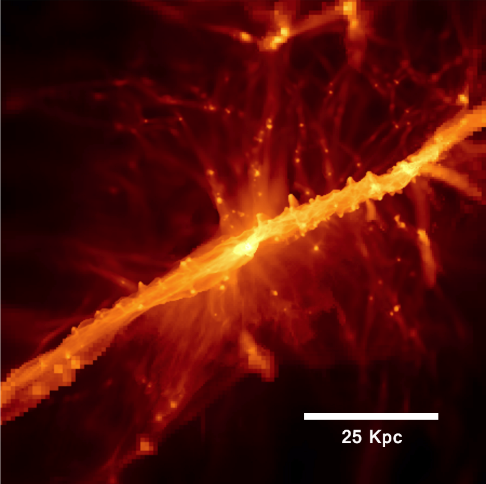
Surrounding galaxies and structures are heated by a black hole’s radiation. This galaxy is emitting “Lyman Alpha” radiation and provides glimpses into the history of the early universe.
Los Alamos researchers recently determined a single instrument, called the James Webb Space Telescope, could actually find a direct-collapse black hole as well as Pop III stars—the brightest starbursts in the early universe.
The telescope is set to launch on an Ariane 5 rocket from French Guiana in 2021. It is an international collaboration among NASA, the European Space Agency, and the Canadian Space Agency.
The Los Alamos team’s research will help direct where the telescope should look for Pop III stars and direct-collapse black holes, but these events are quite rare and may be hard to find. Still, if they are found, it will prove their theory that supermassive black holes form via direct-collapse of massive stars. This is a major advancement in the cosmology and astrophysics communities.
Discovering how supermassive black holes form and grow
Supermassive black holes are just that, very massive. Each contains a mass of up to 50 billion times that of the sun. In 2017, these Los Alamos researchers hypothesized and simulated supermassive black hole formation via direct collapse of a very massive star at the end of its lifecycle. It was the most detailed simulation ever created, and now it can be proven with the James Webb Space Telescope.
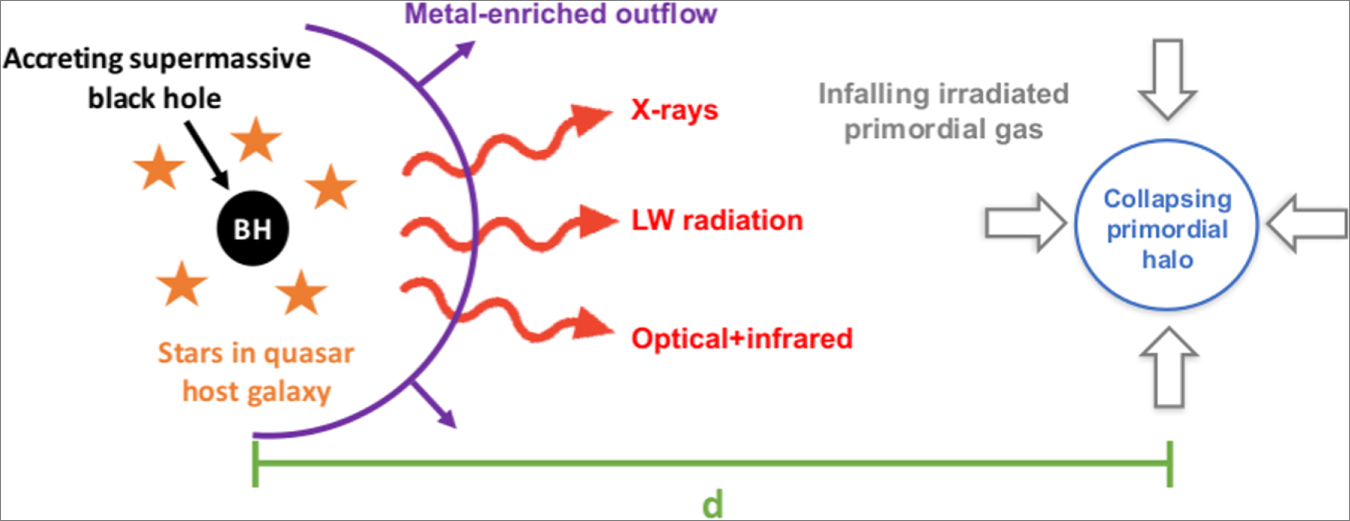
Schematic of the researchers’ prediction, the evolution of collapsing primordial gas (right) under the influence of X-rays, Lyman–Werner (LW), and optical/infrared radiation from a quasar (left) composed of an accreting black hole and stars in its host galaxy. The intense X-ray heating of the primordial gas prevents its collapse into its host halo until the halo mass exceeds ~10E10 M⊙, resulting in the formation of a massive cluster of Pop III stars or a direct-collapse black hole.
The simulation was based on a LANL nuclear computer code used to understand the coupling of radiation and certain materials. Supermassive black holes produce huge amounts of radiation, and therefore, their simulations aid in the vetting of similar physics packages used for the safety and reliability of the U.S. nuclear deterrent.
The simulation, which you can watch here, also answered questions about how supermassive black holes became so large. The researchers explain that black holes of this size likely came from very large stars, of 100,000 solar masses, collapsing.
This is one theory, however, of how supermassive black holes came to be. It can’t be proven until a space telescope spots one.
Funding and mission
This research was funded by a LANL Laboratory Directed Research and Development grant. It supports the Laboratory’s Nuclear Deterrence mission area and the Information Science and Technology and the Science of Signatures capability pillars.
Reference: Jarrett Johnson and Aycin Aykutalp (XTD). “Extreme Primordial Star Formation Enabled by High-redshift Quasars.” The Astrophysical Journal. 2019. DOI: https://doi.org/10.3847/1538-4357/ab223e Technical contacts: Joseph Smidt and Jarrett Johnson









